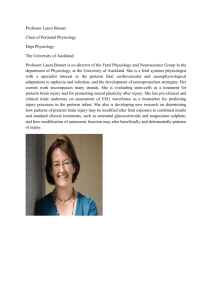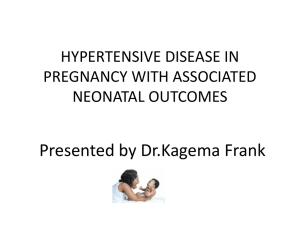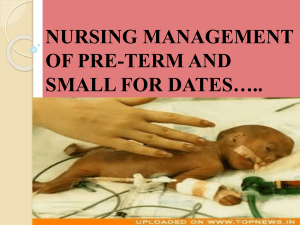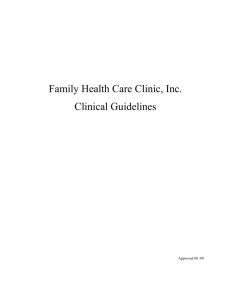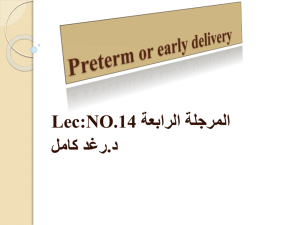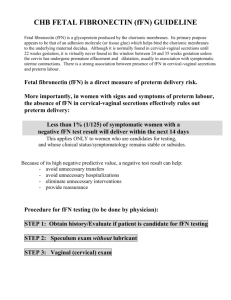OB progress note template
advertisement
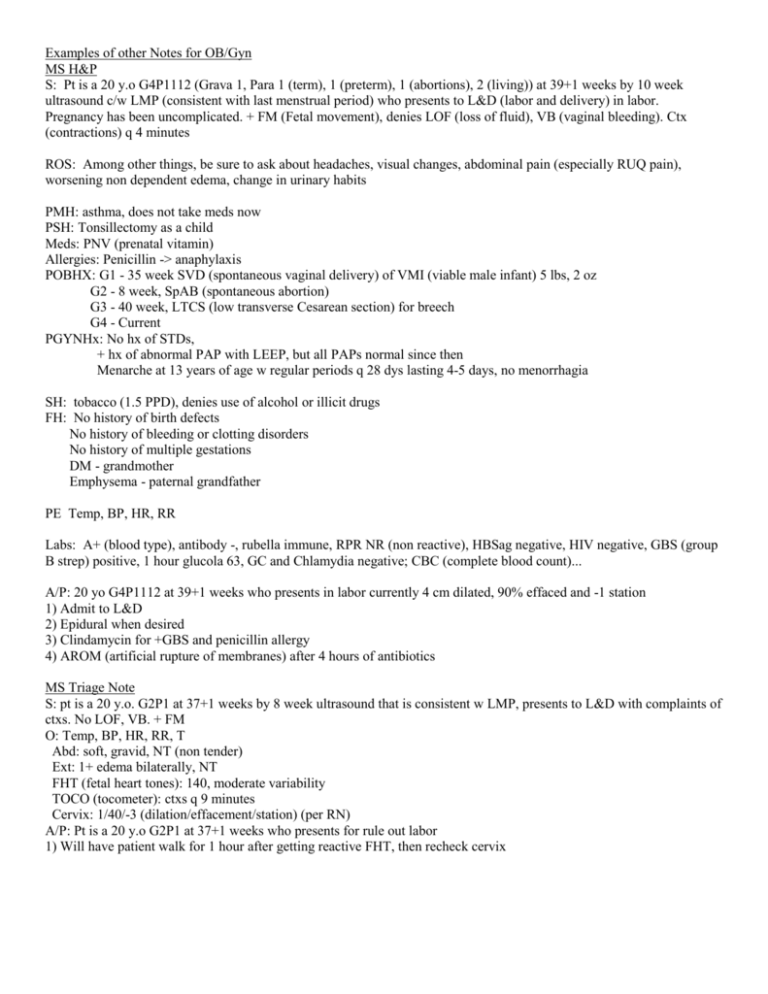
Examples of other Notes for OB/Gyn MS H&P S: Pt is a 20 y.o G4P1112 (Grava 1, Para 1 (term), 1 (preterm), 1 (abortions), 2 (living)) at 39+1 weeks by 10 week ultrasound c/w LMP (consistent with last menstrual period) who presents to L&D (labor and delivery) in labor. Pregnancy has been uncomplicated. + FM (Fetal movement), denies LOF (loss of fluid), VB (vaginal bleeding). Ctx (contractions) q 4 minutes ROS: Among other things, be sure to ask about headaches, visual changes, abdominal pain (especially RUQ pain), worsening non dependent edema, change in urinary habits PMH: asthma, does not take meds now PSH: Tonsillectomy as a child Meds: PNV (prenatal vitamin) Allergies: Penicillin -> anaphylaxis POBHX: G1 - 35 week SVD (spontaneous vaginal delivery) of VMI (viable male infant) 5 lbs, 2 oz G2 - 8 week, SpAB (spontaneous abortion) G3 - 40 week, LTCS (low transverse Cesarean section) for breech G4 - Current PGYNHx: No hx of STDs, + hx of abnormal PAP with LEEP, but all PAPs normal since then Menarche at 13 years of age w regular periods q 28 dys lasting 4-5 days, no menorrhagia SH: tobacco (1.5 PPD), denies use of alcohol or illicit drugs FH: No history of birth defects No history of bleeding or clotting disorders No history of multiple gestations DM - grandmother Emphysema - paternal grandfather PE Temp, BP, HR, RR Labs: A+ (blood type), antibody -, rubella immune, RPR NR (non reactive), HBSag negative, HIV negative, GBS (group B strep) positive, 1 hour glucola 63, GC and Chlamydia negative; CBC (complete blood count)... A/P: 20 yo G4P1112 at 39+1 weeks who presents in labor currently 4 cm dilated, 90% effaced and -1 station 1) Admit to L&D 2) Epidural when desired 3) Clindamycin for +GBS and penicillin allergy 4) AROM (artificial rupture of membranes) after 4 hours of antibiotics MS Triage Note S: pt is a 20 y.o. G2P1 at 37+1 weeks by 8 week ultrasound that is consistent w LMP, presents to L&D with complaints of ctxs. No LOF, VB. + FM O: Temp, BP, HR, RR, T Abd: soft, gravid, NT (non tender) Ext: 1+ edema bilaterally, NT FHT (fetal heart tones): 140, moderate variability TOCO (tocometer): ctxs q 9 minutes Cervix: 1/40/-3 (dilation/effacement/station) (per RN) A/P: Pt is a 20 y.o G2P1 at 37+1 weeks who presents for rule out labor 1) Will have patient walk for 1 hour after getting reactive FHT, then recheck cervix MS Delivery Note SVD (spontaneous vaginal delivery) of VMI (viable male infant) with APGARs 8, 9 over 2nd degree midline laceration. Head delivered atraumatically, mouth and nose bulb suctioned at perineum, loose nuchal cord x 1 easily reduced, shoulders and body delivered without delay or force. Cord clamped and cut and infant handed to awaiting RN. Cord gases obtained. Spontaneous delivery of placenta with 3 VC (vessel cord) intact. No cervical, vaginal vault or periurethral lacerations. 2nd degree midline laceration repaired with 3.0 vicryl suture. EBL (estimated blood loss): 300 cc Anesthesia: Epidural Dr. (attending) present MS Operative Note Pre-operative diagnosis: IUP (intrauterine pregnancy) at term, breech presentation Post-operative diagnosis: same Procedure: primary LTCS via Pfannensteil incision Surgeon: Assistant: Anesthesia: spinal with duramorph Findings: VFI (viable female infant), frank breech, APGARs 8,9, 3VC, intact placenta, normal ovaries EBL (estimated blood loss): 800 cc Fluids: 1800 cc crystalloid UOP (urine output): 200 cc, clear Packs/Drains: foley Complications: none Disposition: Patient and infant stable to PACU (post anesthesia care unit) MS Post-op Check S: Pt resting comfortably. Pain well-controlled. Minimal nausea. No vomiting. O: Temp, BP, HR, RR Gen: NAD, A&O x3 Abd: soft, appropriately tender, ND, absent BS Inc: Dressing clean and intact Ext: No edema, non-tender, SCDs in place A/P: 47 y.o. WF POD #0 TAH/BSO 1) Hemodynamically stable, CBC in am 2) continue routine post-op care MS HROB (High risk obstetrics/Maternal fetal medicine) S: No complaints. Denies VB, LOF, ctx. +FM O: Temp, BP, HR, RR Gen: NAD, A&O x3 Abd: soft, gravid, non tender Ext: No edema, non-tender, DTRs (deep tendon reflexes) 2+ bilaterally, SCDs in place TOCO: No contractions FHT: 135, moderate variability, reactive A/P: 32 y.o. G1P0 at 30+1 weeks with PTL (preterm labor) 1) s/p BMZ (status post betamethasone) 2) Continue bed rest with BRP (bathroom privileges) 3) GBS negative MS PPD (post partum day) #1 S: Pain? Lochia? Ambulating? Breast/bottle feeding? Pain meds used?. Diet?. Voiding? Plan for contraception? O: Temp BP HR RR Gen: Lungs: C/V: Abd: soft? NT/ND? Fundus? (Should be firm, 2 finger breadths below umbilicus) Ext: edema? Palpable cords? DTRs: Labs? A/P: 19 y.o. PPD # __ SVD 1) MWB (maternal well being) - doing well, Rh + or - , RI (rubella immune)? Hgb? 2) FWB (fetal well being) – male/female infant, well?, breast/bottle feeding?, desires circumcision? 3) PPBC (post partum birth control) 4) D/C (discharge) planning MS POD (post operative day) #1 from C/S (can be used for other Gyn surgeries, omitting lochia/fundus) S: Pain Pain meds used? Lochia? nausea or vomiting? Flatus? Diet? Ambulating? Contraception? O: Temp BP HR RR Gen: Lungs: C/V: Abd: soft? Appropriately tender? Fundus? BS? Inc (incision): C/D/I (clean/dry/intact)? Staples/sutures? Ext: tenderness? Edema? SCDs (serial compression devices) in place? Labs? A/P: 55 y.o. WF POD #1 C/S 1) Hemodynamically stable, CBC? 2) advance diet to clears, await flatus for regular diet 3) ambulate with assistance, continue incentive spirometry HELLP syndrome Hemolysis Elevated LFTs Low Platelets Risk factors for Preterm Labor - MAPPS Multiple gestations Abdominal surgery during pregnancy Previous Preterm labor Previous Preterm delivery Surgery of the cervix Contraindications to tocolytics – CHAMPS Chorioamnionitis Hemorrhage Abruption Maturity of fetus Preeclampsia/eclampsia Severe IUGR Risk factors for shoulder dystocia – MOMS on L&D Maternal Obesity Macrosomia Second stage prolonged Late (post-date pregnancy) Diabetes Causes of fetal baseline tachycardia FFAASTT Heart Fetal infection Fever Arrhythia of fetus Anemia of fetus Sympathomimetics Tacycardia of mother Thyrotoxicosis of mother Hypoxia Causes of postpartum hemorrhage - 4T's Tone diminished - Uterine Atony represents 70% Postpartum hemorrhage Tissue - Retained Placenta - Placenta accreta Trauma - Uterine Inversion - Uterine Rupture - Cervical Laceration - Vaginal hematoma Thrombin - Coagulopathy
